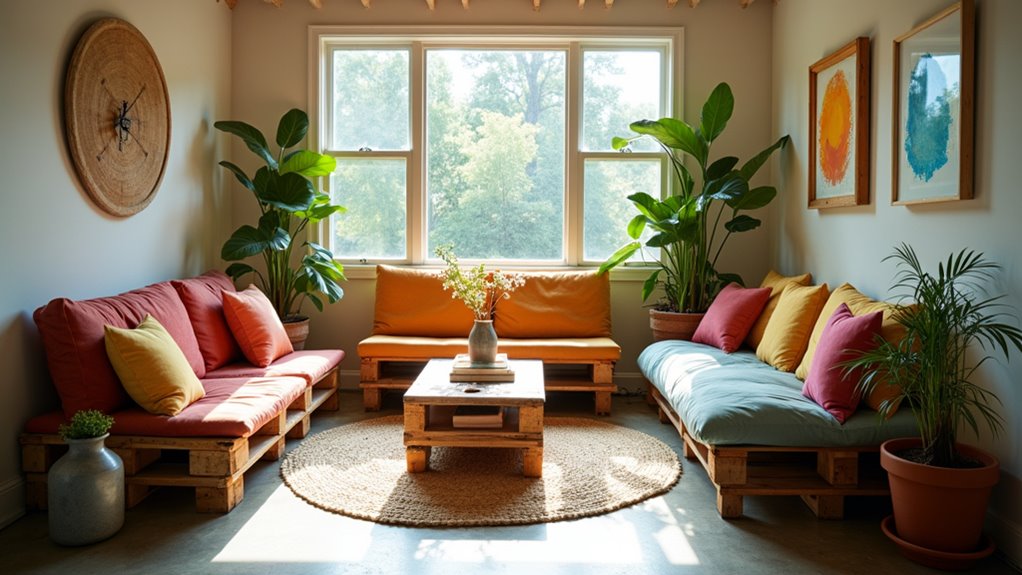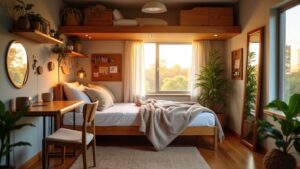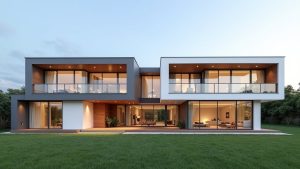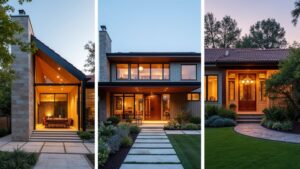Designing a low-budget, simple house is achievable with smart strategies. Embrace open floor plans to cut wall costs. Use reclaimed wood or fly ash bricks for affordable, eco-friendly materials. Prioritize south-facing windows for energy-saving warmth. Opt for multi-functional furniture like sofa beds. Maximize vertical space with wall-mounted shelves. Source budget supplies from salvage yards. Incorporate natural light via skylights. Create basic outdoor areas with gravel. Plan phased upgrades for flexibility. Explore further for deeper insights!
Key Takeaways
- Opt for simple, open floor plans to reduce wall and foundation costs while maximizing space efficiency.
- Use cost-effective materials like reclaimed wood or fly ash bricks for sustainable, affordable construction.
- Design basic gable or shed roofs to minimize material waste and installation expenses.
- Incorporate south-facing windows and natural lighting to lower energy and artificial lighting costs.
- Maximize space with multi-functional furniture and vertical storage solutions like wall-mounted shelves.
Embrace Simple Floor Plans
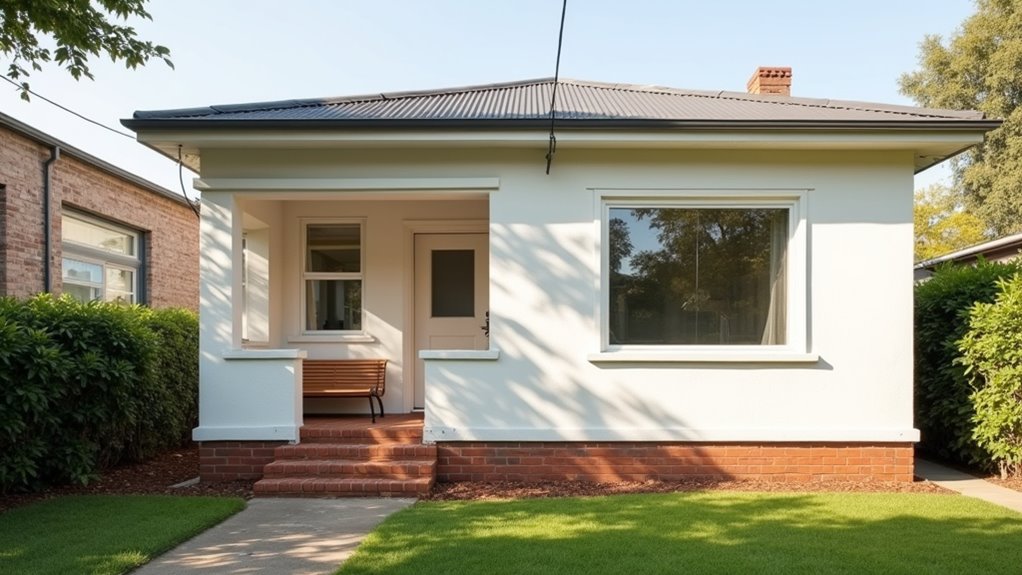
A cornerstone of low-budget house design lies in embracing simple floor plans, where elegance meets economy. By prioritizing open layouts, spaces like living, dining, and kitchen areas merge seamlessly, reducing the need for interior walls and cutting down on framing costs. This design not only saves money but also creates an airy, expansive feel in modest homes.
Simple floor plans blend elegance and economy, merging living spaces for cost savings and an airy, expansive feel in modest homes.
Compact footprints, such as square or rectangular shapes, further enhance efficiency by minimizing exterior wall area and simplifying foundation work, directly lowering labor and material expenses. Aligning walls and grouping systems like plumbing and electrical in close proximity can also streamline construction and reduce installation costs.
Additionally, straightforward rooflines and standardized dimensions curb waste and construction complexity. Eliminating unnecessary corners and transitional hallways ensures every square foot serves a purpose, often through multi-functional rooms or built-in storage. Opting for standard material sizes can further reduce material waste and keep costs in check.
Vertical space utilization, like opting for two-story builds, maximizes living area without sprawling foundations. Such thoughtful simplicity crafts homes that are both cost-effective and charmingly functional.
Opt for Cost-Effective Building Materials
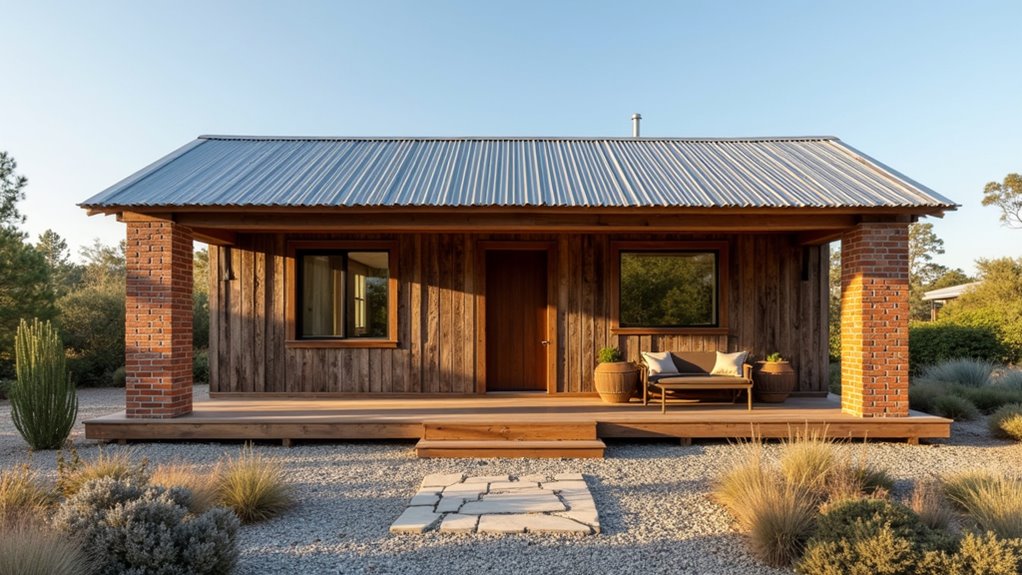
When exploring cost-effective building materials, one can consider the rustic charm of reclaimed wood, which not only slashes expenses but also infuses a home with historical depth.
Prefabricated panels offer another savvy choice, streamlining construction with factory precision while curbing labor costs.
Additionally, opting for fly ash in concrete mixes presents an innovative way to reduce expenses and enhance sustainability with a byproduct that strengthens structures.
Use Reclaimed Wood
Embracing reclaimed wood as a building material offers an innovative pathway to crafting a low-budget home with character and sustainability at its core. Its Rustic Charm adds unique textures and historical depth, while supporting Sustainable Living by reducing deforestation and carbon footprints. Sourced from old structures, it boasts durability and stability, often outlasting new lumber.
For practical application, consider its varied costs and quality. While upfront expenses may be higher, long-term value shines through. Below is a snapshot of benefits and considerations:
| Aspect | Details |
|---|---|
| Aesthetic Appeal | Unique grains, knots, rustic tones |
| Environmental Impact | Lowers waste, preserves resources |
| Cost Factors | Varies by source, condition, species |
Choose Prefabricated Panels
As the pursuit of affordable housing solutions gains momentum, opting for prefabricated panels emerges as a savvy strategy for budget-conscious builders. These panels, crafted off-site, unlock numerous prefab advantages, such as slashing labor costs by up to 50% and accelerating construction timelines by 20-50%.
Their factory precision minimizes material waste, ensuring predictable budgets and long-term savings through energy-efficient designs.
Diving into panel types, options like Structural Insulated Panels (SIPs) offer robust insulation, while lightweight steel frame panels provide durability. Precast concrete panels blend affordability with aesthetic appeal, and sandwich panels like EPS deliver cost-effective thermal protection.
Opt for Fly Ash
Builders seeking affordable yet innovative materials can find a powerful ally in fly ash, a byproduct of coal combustion that transforms industrial waste into a cornerstone of cost-effective construction. This versatile material, used in bricks and as a cement substitute in concrete, offers remarkable cost reduction by slashing production and transportation expenses.
Fly ash bricks, lighter and more uniform, save on mortar and plastering costs while boasting high compressive strength for lasting durability.
Beyond savings, fly ash champions eco-friendly construction by reducing landfill waste, cutting CO2 emissions, and conserving natural resources. Its smooth finish often eliminates plastering needs, and improved concrete workability enhances application ease.
For budget-conscious builders, fly ash delivers both economic and environmental wins in simple house designs.
Prioritize Energy-Saving Designs
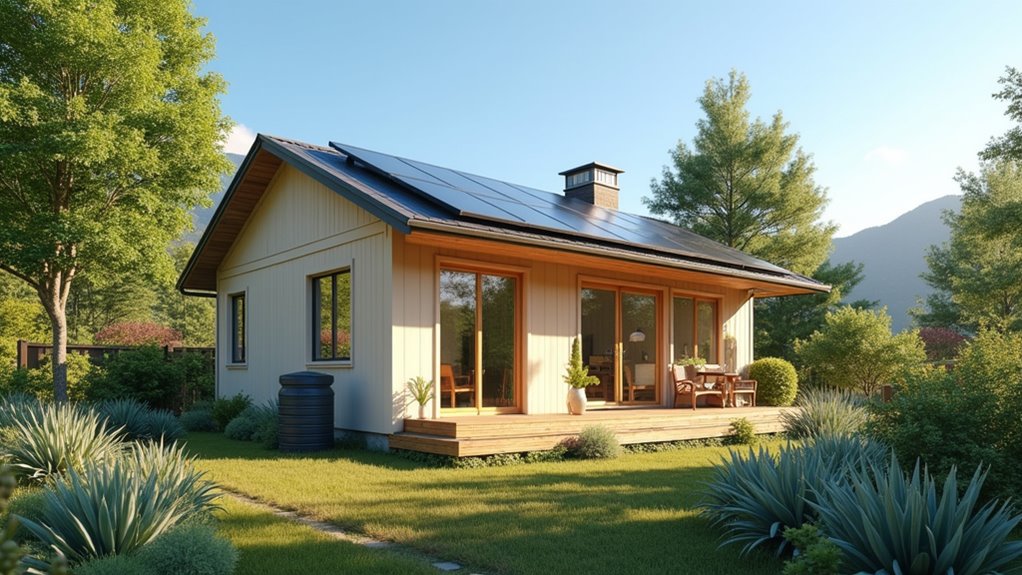
How can a modest budget transform a home into an energy-efficient haven? By embracing clever passive solar design, homeowners can harness nature’s power without breaking the bank.
Prioritizing solar orientation ensures south-facing windows capture winter warmth, while minimizing openings on colder sides reduces heat loss. Incorporating thermal mass with materials like concrete or brick in sunlit areas allows the home to store daytime heat and release it at night, maintaining a cozy balance.
Harness winter warmth with south-facing windows and thermal mass like concrete, storing daytime heat for cozy nights, all while cutting energy loss.
Beyond orientation, budget-friendly insulation, such as loose-fill for attics or reflective foil, curbs heat escape, potentially saving significant energy costs. Draught-proofing with simple weather stripping seals sneaky air leaks, and double-pane windows with thermal curtains add affordable efficiency.
Strategic shading prevents summer overheating, while cross-ventilation cools naturally. Even on a tight budget, these practical tweaks weave energy-saving magic into a home’s very fabric, proving sustainability needn’t be a luxury.
Maximize Space With Multi-Functional Furniture
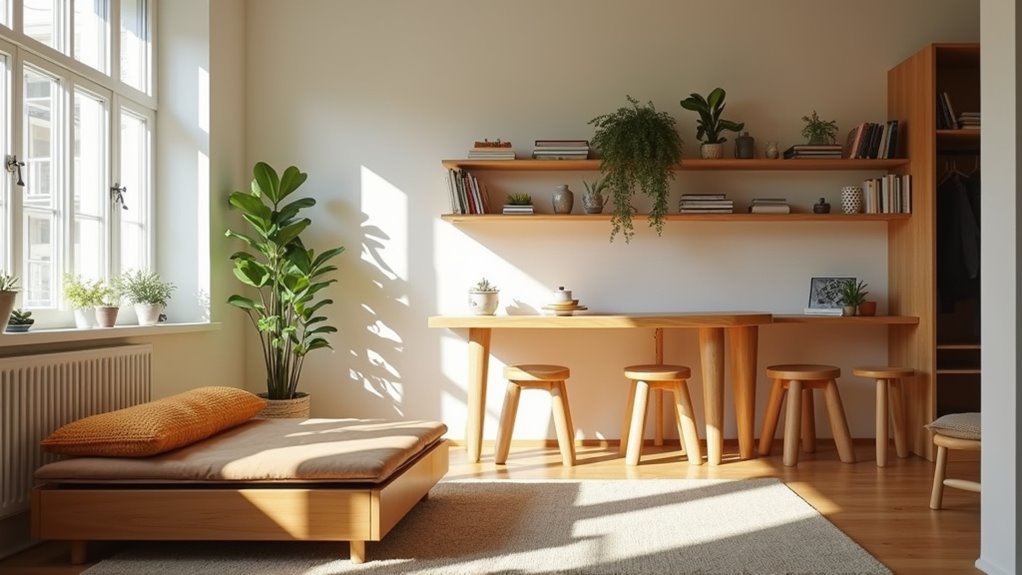
Homeowners crafting a low-budget sanctuary can shift focus from energy-saving designs to clever space optimization with equal ingenuity. Multi-functional furniture offers a brilliant solution, transforming cramped quarters into versatile havens.
Pieces like folding beds, which tuck away to reveal open floor space, redefine bedrooms as daytime retreats or workspaces. A sofa bed in the living area doubles as guest lodging, while storage ottomans hide clutter beneath plush seating.
In compact workspaces, desks with integrated shelving pair practicality with style, and tablet stands on modular surfaces adapt to digital needs without claiming extra room. Dining areas benefit from extendable tables, morphing to host gatherings then shrinking for daily use.
Budget-conscious buyers can explore thrift stores or DIY projects, crafting custom pieces that maximize utility. Such furniture not only saves space and money but also weaves minimalism into the fabric of a well-organized, adaptable home.
Utilize Vertical Storage Solutions
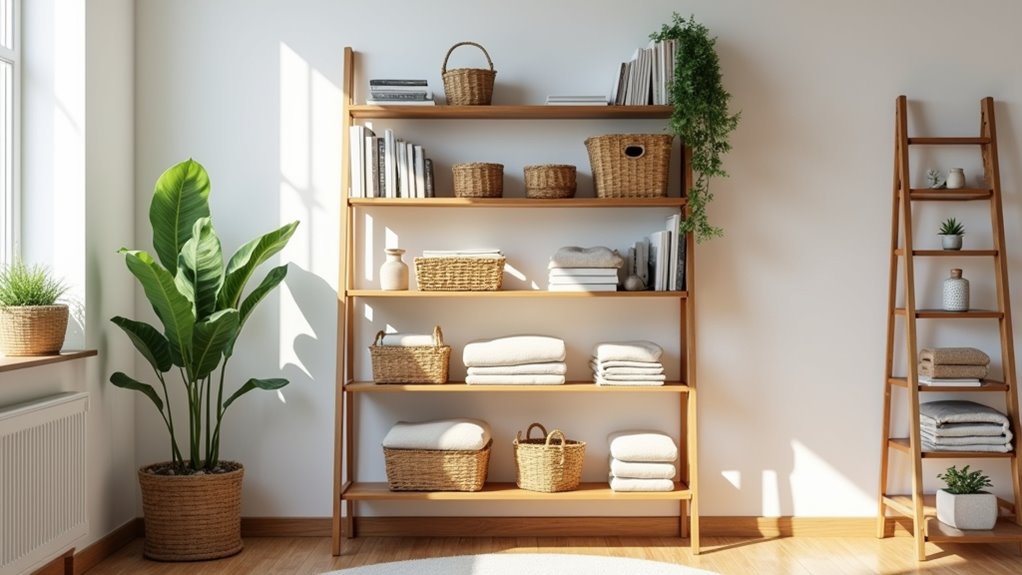
Why settle for cluttered floors when the walls offer untapped potential? Vertical storage solutions transform empty spaces into functional havens, especially in modest homes.
Don’t let cluttered floors hold you back—tap into the hidden potential of your walls with smart vertical storage for any home!
Modular shelving, with its adjustable configurations, adapts to changing needs, whether in a kitchen for spices or a living room for books. Floating shelves bring a sleek, minimalist charm, while corner units cleverly utilize neglected nooks.
Beyond shelves, wall mounted racks offer practical flair—think over-the-door organizers for shoes or pantry items, requiring no drilling. Hanging hooks and magnetic strips keep essentials like coats or utensils within reach.
For a budget-friendly twist, repurpose wooden crates or pallets into rustic shelves, or use tension rods with wire grids for customizable storage.
Even under-stair areas or above-toilet spaces can house cabinets or stackable bins, ensuring every inch serves a purpose. Vertical storage maximizes space without sacrificing style or breaking the bank.
Keep Roof Designs Basic

Crafting a home on a tight budget demands smart choices, and opting for a basic roof design stands out as a cornerstone of cost efficiency. Simple structures like gable or shed roofs, with their minimal slopes and straightforward lines, not only reduce material needs but also cut down on waste, embodying cost effective roofing. Their triangular or single-plane forms require fewer specialized accessories, keeping expenses low while ensuring functionality.
Beyond initial savings, simple roof durability shines through in long-term benefits. With fewer joints and angles, these designs resist leaks and weather damage, minimizing repair costs. Maintenance becomes a breeze, especially with flat roofs that offer easy access.
Labor costs drop too, as basic designs demand less time and skill to install. By prioritizing simplicity, homeowners craft resilient shelters that balance affordability with lasting strength, proving that less can be indeed be more.
Source Budget-Friendly Supplies
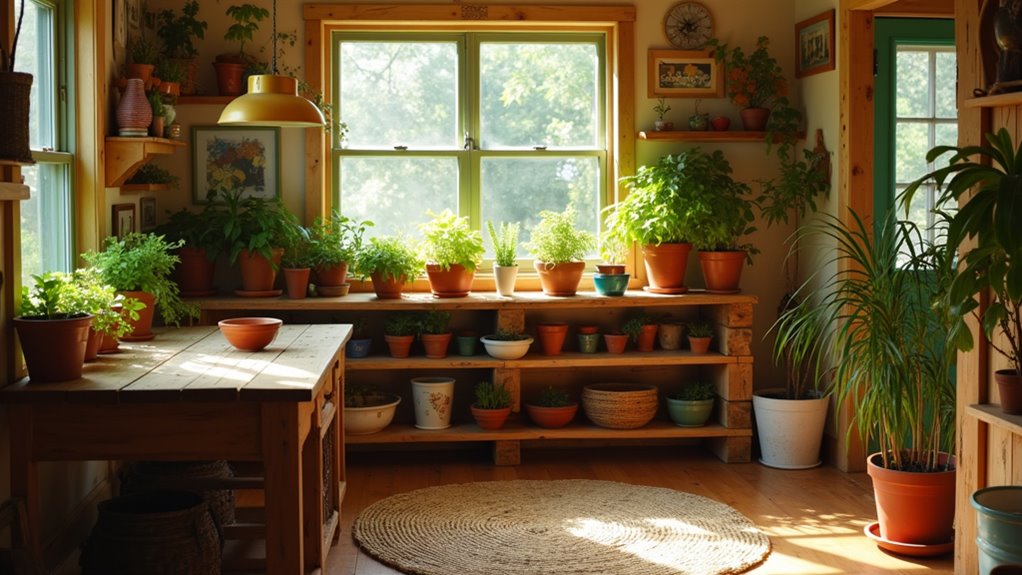
For those crafting a home on a tight budget, scouring local salvage yards unveils a treasure trove of unique materials. from weathered beams to vintage doors, often at a steal. Shopping at wholesale material outlets offers another savvy avenue, providing bulk supplies like lumber and tiles at reduced rates without the retail markup.
Additionally, hunting for second-hand fixtures through online marketplaces or garage sales can yield functional gems, such as faucets or lighting, that add character without breaking the bank.
Explore Local Salvage Yards
Countless homeowners seeking affordable building solutions can uncover hidden treasures by exploring local salvage yards. These havens of reclaimed goods offer cost savings of 50-75% on items like doors and moldings, while promoting sustainability by reducing landfill waste. Unique finds, such as vintage signage and decorative corbels, add character and historical charm to any home design.
Visiting yards in person reveals weathered patinas and superior old-growth wood, often unavailable in new materials. Below is a glimpse of potential discoveries:
| Item Category | Examples |
|---|---|
| Architectural Elements | Doors, decorative corbels |
| Building Materials | Lumber, bricks |
| Fixtures & Decor | Vintage signage, lighting |
| Structural Components | Steel beams, concrete |
| Outdoor & Landscaping | Pavers, fencing |
Shop Wholesale Material Outlets
Savvy homeowners and builders hunting for cost-effective solutions can tap into substantial savings by turning to wholesale material outlets. These distributors offer bulk construction supplies at discounted rates, making them ideal for DIY renovations.
From lumber to flooring, they stock a wide range of premium materials without the hefty retail markup, ensuring quality for budget-conscious projects.
To maximize benefits, one should research local wholesalers, compare quotes, and plan bulk purchases meticulously. Establishing partnerships with trusted suppliers can unlock better pricing and services like delivery or design assistance.
Though minimum order quantities may pose challenges, strategic planning and adequate storage can turn wholesale shopping into a practical goldmine for crafting a dream home affordably.
Buy Second-Hand Fixtures
Beyond the savings found at wholesale material outlets, another clever approach to building or renovating on a budget involves exploring the world of second-hand fixtures. These treasures, often brimming with vintage charm, can be unearthed at Habitat for Humanity ReStores, salvage yards, or online marketplaces like Craigslist.
Not only do they slash costs by up to 50%, but they also promote sustainability by reducing waste and energy use.
Unique fixtures, from retro chandeliers to weathered doors, add distinctive character to a home while supporting local businesses or nonprofits. However, buyers must inspect items for damage or functionality, ensuring quality matches intent.
This practical strategy transforms budget constraints into opportunities for creativity and environmental responsibility in home design.
Incorporate Natural Lighting

How can a home be transformed into a haven of light without breaking the bank? By embracing natural light, homeowners can create bright, uplifting spaces on a budget.
Strategic window placement ensures sunlight floods in, reducing the need for artificial lighting while enhancing mood and energy efficiency. Thoughtful design choices amplify this glow without hefty costs.
Clever window placement invites abundant sunlight, cutting lighting costs while uplifting spirits and boosting energy savings with ease.
Here are practical ways to maximize illumination affordably:
- Optimize Window Placement – Position larger windows on sun-facing walls to capture maximum natural light.
- Use Reflective Colors – Paint walls in soft whites or pastels to bounce light around rooms.
- Add Mirrors – Place them opposite windows to double the brightness effortlessly.
- Incorporate Skylights – Install budget-friendly sun tunnels to illuminate darker areas.
These simple tweaks transform dim spaces into radiant retreats, proving that a luminous home doesn’t require a lavish budget, just clever planning.
Create Affordable Outdoor Areas
Moving from the brilliance of indoor natural light, attention can shift to crafting inviting outdoor spaces without straining finances. Homeowners can transform patios with budget-friendly gravel or concrete pavers, creating stylish yet affordable surfaces.
DIY outdoor furniture, made from repurposed pallets or cinder blocks, adds charm and functionality without high costs. For ambiance, outdoor lighting can be both economical and enchanting—solar-powered pathway lights or string LEDs offer a warm glow while slashing energy bills.
Landscaping on a dime is achievable with perennials or seed-grown plants, paired with homemade compost for nourishment. Container gardens in painted pots bring vibrant pops of color to small areas.
For seclusion, privacy screens crafted from slatted wood or trellis with climbing vines provide a natural barrier. Shade sails or curtains further enhance comfort, turning modest yards into cozy retreats with minimal investment.
Plan for Phased Improvements
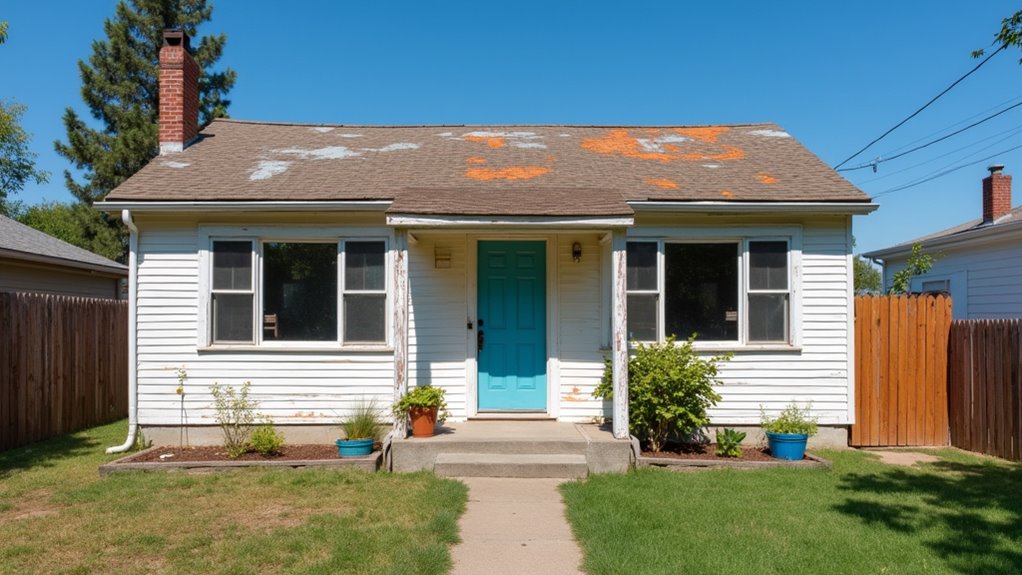
While the allure of a fully renovated home is tempting, embarking on a phased improvement plan offers homeowners a practical pathway to transform their space over time without financial strain.
By adopting phased scheduling, they can manage costs, minimize disruption, and adapt designs as needs evolve.
Strategic planning ensures a cohesive vision through a master plan, guiding each step with purpose.
Consider these relatable steps to navigate the journey:
- Craft a Vision: Draft a long-term plan with a designer to align all phases.
- Prioritize Wisely: Tackle urgent fixes like plumbing before aesthetic upgrades.
- Budget Smartly: Allocate funds per phase, including a contingency buffer.
- Time it Right: Set realistic timelines, allowing breaks to recharge.
This approach lets homeowners live amidst progress, adjusting plans between phases.
Though costs may rise over time, the flexibility and control make phased improvements a savvy, detailed choice.
